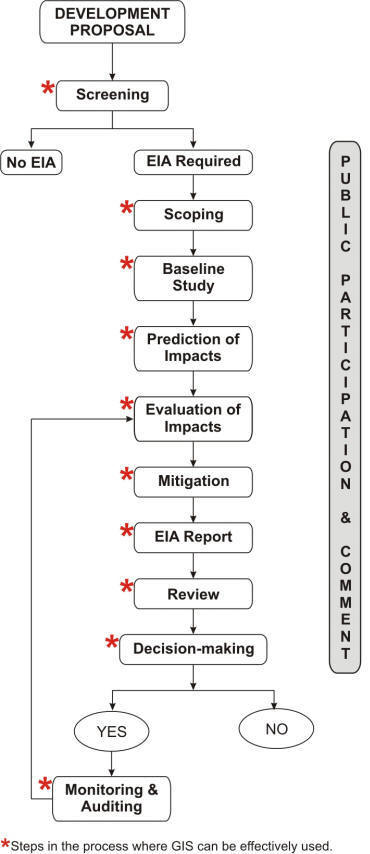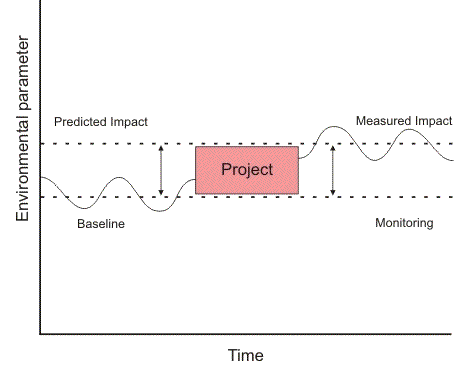2.2 The Environmental Assessment (EA) Process
This object will aim to give students a better understanding of the framework and phases of the EA process. As a generic framework, Environmental Assessment can be viewed as a process that:
- identifies possible environmental effects;
- proposes measures to mitigate adverse effects; and
- predicts whether there will be significant adverse environmental effects, even after the mitigation is implemented
Environmental Impact Assessment (EIA) and Strategic Environmental Assessment (SEA) are applied to development proposals with potential negative impacts on the biodiversity, social stability and structures, and economic prosperity of an area or region. To get to grips with how EIA and SEA complement each other, the two processes will be examined separately, studying the different methodological approaches and underlying principles of each.
Scope and principles of EIA
The general framework of an EIA process follows the following logic:
- Screening:
Determine whether EIA is needed. This is usually determined through regulatory requirements. If an EIA is not needed, the project can go ahead. - Scoping:
Describes the project, and identifies potential impacts and possible alternatives. This part of the process determines, therefore, the limits and scope of the degradation that will be associated with the project. It controls the cost and time of the assessment by deciding the scope of the EIA as well as controlling the size of the EIA. - Baseline Study:
Study of the original status of environment – biophysical, social & economic – before the development project is started. It is used as a base reference against which changes / impacts will be measured. In many cases the scoping and baseline studies flow into each other, since the information for the baseline study will be utilised in the scoping study. Generally baseline studies are more easily prepared in countries where technical expertise and organised environmental databases are readily available. - Impact Assessment:
This involves the prediction and evaluation of impacts. This step is usually the most technical, and therefore the most difficult and controversial part of the whole process. The significance and importance of impacts are evaluated, usually through some quantification process. Examining the impacts of alternatives also form part of this step. - Mitigation Measures:
These measures are there to reduce the magnitude and negative impacts associated with the development. Although these measures can be costly in the short-term, they should make the development more economically and environmentally viable in the long run. - Reporting and Reviewing:
In the report, in some cases called the Environmental Impact Statement (EIS), the study is documented. The methodology used, the results, an interpretation of the results, and the conclusions reached. During the reviewing phase, the adequacy of the issues addressed are assessed. - Decision-making:
The final decision is usually made by an official (or committee) of the relevant government ministry. The decision-maker(s) have one of three choices, namely (1) accepting one of the project alternatives; (2) returning the EIA with a request for further study in certain specific areas; and (3) totally rejecting the proposed project along with alternative versions. - Monitoring:
Monitoring and auditing is takes place during the implementation of the project and ensures that the guidelines and recommendations stated in the EIA are followed. Ideally monitoring should continue after completion of the project to determine to what extend the impact prediction was accurate, hence increasing knowledge acquisition for future decision-making processes.
Public participation and stakeholder involvement occurs throughout the process and forms part of the information gathering as well as reporting and reviewing of the proposal.

Figure 1: EIA framework
The prediction of impacts and the effect they might have on the environment (whether biophysical, social or economic) is a very important part of the EIA process. An impact can be described as a change in an environmental parameter as a result from a particular activity or intervention. The change is the difference in the state of the environmental parameter with and without the project, when no mitigating measures are taken into account. Impact prediction also provide a framework within which the project can be monitored, thereby preventing adverse effects taking place after project completion.


Impact assessment is the part where specific impacts associated with each phase of the project are identified; the nature, magnitude, extent and duration of impacts are predicted; and the significance of residual impacts are evaluated, after the considerations of mitigating measures. Methods for impact prediction include:
- ‘Best estimate’ professional judgement (e.g. the impact of the effect of a new water supply system on the social activities of women in a village);
- Quantitative mathematical models (e.g. aquatic models to determine the change in biota from an increase in toxic discharge);
- Experiments and physical models (e.g. field trials to determine the effectiveness of certain erosion control measures); and
- Case studies as analogues or points of reference.
Case Study
See the references below for case studies of SEA in practice.
Strategic Environmental Assessment
SEA developed through the implementation of EIA. Some characteristics of SEA could be seen in the EIA processes that were followed in Canada and Australia during the mid-1970s, such as the consideration of policy issues in the Mackenzie Valley Pipeline Inquiry in Canada (1974-1977) and the Ranger Uranium Environmental Inquiry in Australia (1975-1977). During the 1980s, more countries started to adopt SEA type processes, e.g. Denmark, the Netherlands, the UK and New Zealand (amongst others). Although it is not a legal requirement everywhere, most countries have now adopted SEA as an integral part of the EA process, especially to enhance strategic planning and decision-making. In the European Union, the SEA Directive came into force on 21 July 2004 and it requires all member states to adopt procedures in which plans and programmes are assessed to limit adverse environmental impacts.
The differences between EIA and SEA is outlined in this Table, which can be used as a guide to understand the concepts and principles of the two processes. Very often SEA is related to sustainability principles, in that it can be used to assist decision-makers to develop more sustainable policies and strategies (i.e. plans and programmes), allowing the principles of sustainability (such as recognising the interdependence between systems and elements in the natural and human environment; reducing the impact of society on the environment, etc.) to trickle through to project-level. Unlike EIA, there is not an established methodological model for SEA. This is mainly due to the different levels of SEA and the fact that there is not necessarily global agreement on how SEA should be conducted. In general, however, two basic approaches can be identified, i.e. EIA-based strategic environmental assessment and sustainability-led / appraisal based SEAs.
The EIA-based methodology focus much more on prediction and mitigation of impact, and the techniques preferred are quantitative rather than qualitative. Many plan and programme SEAs are conducted in this manner. The sustainability-led / appraisal based SEAs can have a more qualitative approach and focus more on impact identification, and the subsequent mitigation and management of these impacts. This methodology is more often (although not exclusively) used for policy SEAs, in an effort to facilitate the integration of environmental aims in the policy-making process.
SEAs conducted for policy needs to be aiding policy formulation and should not be used to justify the policy already formulated. Policy is a broad statement of intent, very often with certain objectives and courses of action that will assist in meeting the objectives. Examples of SEAs for policy review is very limited and very few countries have SEA for policy as a statutory requirement. An example of an instrument that has given effect to policy SEA is the Environmental Test (E-Test) for draft legislation in The Netherlands, which enables a policy to be assessed against its environmental and social consequences.
Plan and Programme SEAs can have more structured methodologies, especially when following the EIA-based approach, e.g. those that initiate or set the framework for major projects as in the SEA Directive. The Directive identified five stages of the SEA process as general guidelines for the Member States.

The International Association of Impact Assessment (IAIA) established six criteria for SEA, namely that it should be:
- Integrated;
- Sustainability-led;
- Focused;
- Accountable;
- Participative; and
- Iterative
It is important to note that SEA should not just analyse a policy, plan or programme (PPP), but should improve it. It is therefore more advantages to start the SEA process as soon as possible after a PPP has been recommended. It should be part of the creative process of decision-making, rather than a separate part of the planning process. SEA should also not just choose between alternatives mentioned, e.g. choosing between nuclear energy or wind farms for reducing the dependency on oil and gas as an energy source. It should go further and recommend strategies for reduction in energy consumption and using smaller scale wind and solar generation methods (e.g. on individual houses) as oppose to large-scale industrial type energy generation methods.
The Levitt-Therivel consultancy report from 2003 below gives a specific case study about the impact of the SEA Directive on local transport plans in the UK.
Activity
Besides overlay techniques, one or a combination of the techniques listed below are usually employed during an EIA. Briefly describe ONE of these techniques within the EIA process, listing the pros and cons and how the technique can be incorporated within a GIS as part of a decision support framework, if at all? After you’ve finished, post your results to the course message board for further discussion.
- Checklists;
- Matrices;
- Networks;
- Expert Systems
References (Essential reading for this learning object indicated by *)
These resources can all be used to support activity 1:
* This European Union site provides some examples of checklists that can be used at different stages of an EIA: http://ec.europa.eu/environment/eia/eia-support.htm
The United Nations University provides a useful in-depth resource on EIA here: http://www.raymondsumouniversity.com/eia-local/index.html
This paper describes causal networks in EIA in greater detail, as well as some of the other techniques such as matrices:
* Perdicoulis, A., and Glasson, J. (2006) Causal Networks in EIA. Environmental Impact Assessment Review 26 (6), 553-569. http://www.sciencedirect.com/science/article/pii/S019592550600045X
Several case studies for SEA are available in the following papers:
Gonzalez, A., et. al. (2011) Applying geographic information systems to support strategic environmental assessment: opportunities and limitations in the context of Irish land use plans. Environmental Impact Assessment Review 31 (3), 368-381. http://www.sciencedirect.com/science/article/pii/S0195925510001484
Barth, R and Fuder A. (2002). Implementing Article 10 of the SEA Directive. Institute for Applied Ecology, Darmstadt. https://ec.europa.eu/environment/archives/eia/pdf/impel_final_report.pdf
These journals all publish relevant articles:
Environmental Impact Assessment Review: http://www.elsevier.com/wps/find/journaldescription.cws_home/505718/description#description
Environmental Modelling & Software: http://www.elsevier.com/wps/find/journaldescription.cws_home/422921/description#description
Journal of Environmental Management: http://www.elsevier.com/wps/find/journaldescription.cws_home/622871/description#description
International Institute for Environment & Development: http://www.iied.org/
Books & other non-web related articles (for those interested in exploring EIA & SEA further – you DO NOT need to read these books to complete the activities):
Canter, L. W. (1996) Environmental Impact Assessment. McGraw-Hill, New York.
Morris, P., and Thérival, R. (Ed.) (2001) Methods of Environmental Impact Assessment. Spon Press, London.
Thérival, R., and Partidario, M. R. (1996) The Practice of Strategic Environmental Assessment. Earthscan, London.